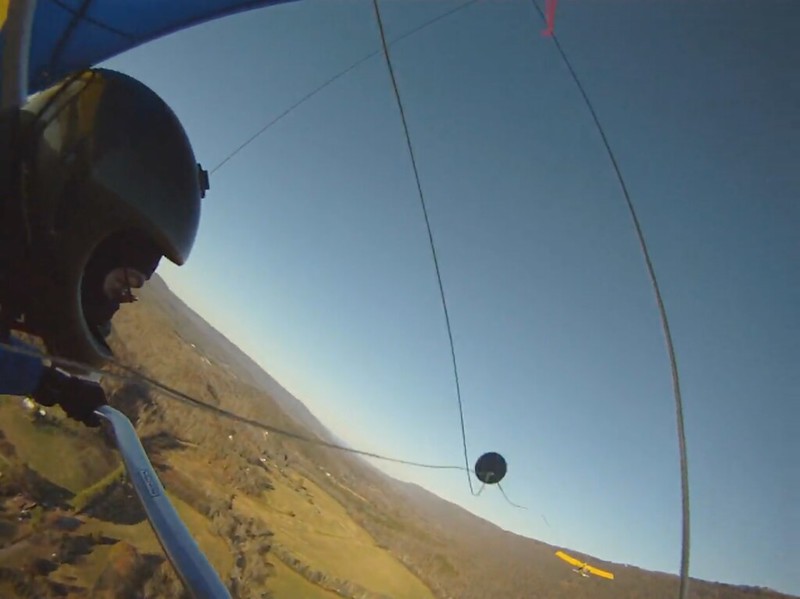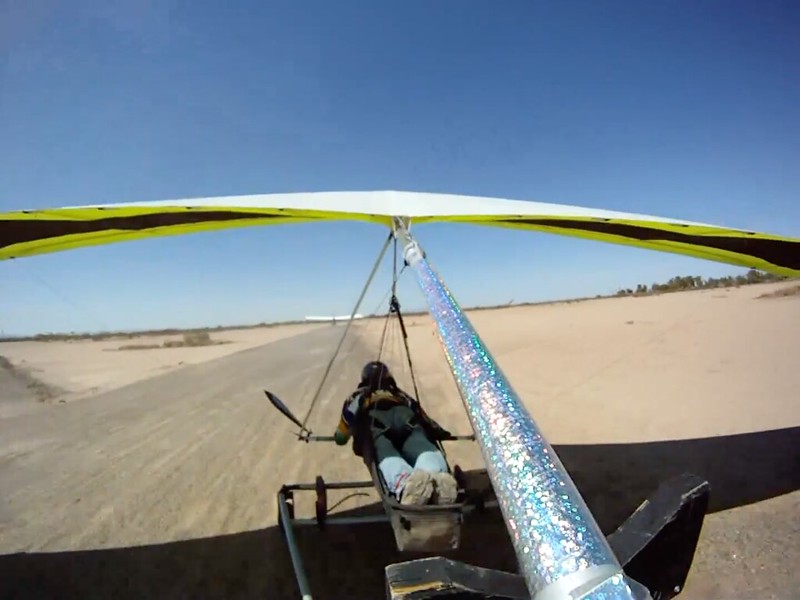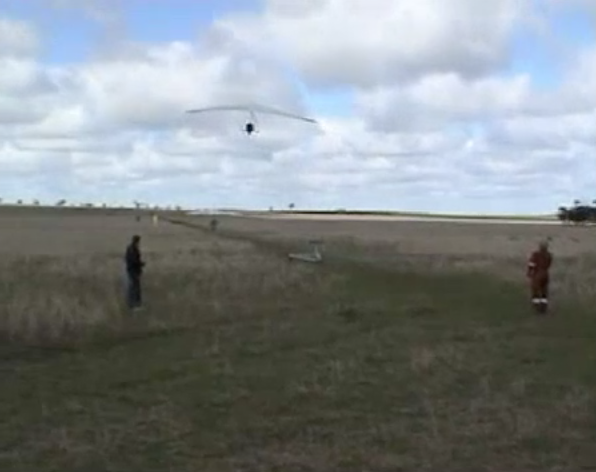http://www.paraglidingforum.com/viewtopic.php?t=2859
Towing safety
James Bradley - 2005/06/21 22:15:17 UTC
New York City
Paraglider towing really unnerved me at first. I have done enough of it now to feel confident with it and to get my USHGA towing signoff, but my experience is still limited to 35 tows and it still feels a bit spooky to do it.
Here are some things I think I know about towing. Please chime in with corrections, amplifications, better information, or just your own experiences.
You have your goddam towing signoff - presumably by paying one of USHGA's highly qualified instructors. What do you expect to find out here that you shouldn't have had down solid before you were ever off the ground on the end of a string?
Almost all my towing has been with "payout" winches on vehicles or boats.
You want a winch operator who either has a lot of experience, or who is being assisted by someone with a lot of experience. The operator has a large responsibility, especially in the first part of your flight.
I don't know what the BFD's supposed to be on this. You just tow up and, if anything starts going wrong, the operator...
http://www.chgpa.org/forums/viewtopic.php?f=2&t=2467
weak links
Jim Rooney - 2007/08/01 13:47:23 UTC
Whatever's going on back there, I can fix it by giving you the rope.
...can fix it just by giving you the rope.
Right after takeoff is the most dangerous time, of course, because you are close to the ground. If you use way too much brake, and/or if your winch operator uses way too much tension...
You're supposed to call it "pressure".
...you could stall without room to recover.
Why would having too much tension produce a stall?
If you are inattentive or make wrong corrections you could turn away from the tow line and lock out, and if your winch operator does not attentively release tension as you do, you could hit the ground hard.
What's stopping YOU from releasing tension?
At the end of the tow, I prefer to release as soon as I see the car or boat stop, because there is still tension on the line and it is easy to release. Staying on for the last twenty feet of altitude means the line goes slack, and my bridle suddenly requires two hands or a hand and a foot to release.
It also means you get higher - which is the whole point of this expensive dangerous operation.
By then I am normally high, so I have time to deal with it...
Yes. You have time to deal with it.
...but I don't like it when I have any trouble disconnecting...
If you're not under any tension worth mentioning, what's it matter?
...so I prefer to release a few seconds earlier.
That could also mean you that you're gonna land a couple of hours earlier. Your idiot instructor should've trained you to do this right.
With a fixed winch or a loop winch, some people do "step" towing. You get pulled up across the field, then without disconnecting you turn and fly back downwind while the operator freely pays out the line, then you turn back upwind and get towed up again going upwind. One risk is if something jams the line while you're flying downwind, you could find yourself in a strong downplane without a lot of room above the ground.
Which is why it's a really bad idea to turn downwind without a lot of room above the ground in the first place.
Seems like it would be prudent to fly downwind with one hand on the tow release...
When would it NOT be prudent to be flying with a release you can blow at will without delay or control compromise?
...but if it's thermic you might not want to put the brakes in one hand to do that.
I might not want to go up with anything which necessitates a control compromise to effect a release. Sounds like you don't either. How tough would it be to rig a bite actuated release for these things? (You assholes could do it in your sleep but you get away with this bullshit at a high enough frequency that you don't bother.)
Some very experienced people refuse to do step towing. I have not done it and I think if I can't find a thermal and get away from a one pass tow, I'm ok with not flying that day, but I'd be interested to hear your experiences.
Then why bother going out in the first place?
You will have a "weak link" between your bridal and the towline...
Of course we will.
Manned Kiting
The Basic Handbook of Tow Launched Hang Gliding
Daniel F. Poynter
1974
"The greatest dangers are a rope break or a premature release." - Richard Johnson
http://ozreport.com/forum/viewtopic.php?t=24846
Is this a joke ?
Jim Rooney - 2011/08/26 02:44:10 UTC
The "purpose" of a weaklink is to increase the safety of the towing operation. PERIOD.
Why would any responsible pilot not want to increase the safety of the towing operation when the means of doing so is so simple?
...a loop of line that is designed to fail at a certain amount of load.
Yes - a CERTAIN amount of load.
Get some advice from an expert about weaklinks...
- Oh yes. Definitely get some ADVICE from an EXPERT about weak links.
- I thought we already knew everything we needed to about weak links. They're designed to fail at a certain amount of load.
- Didn't you just pay a fucking expert about weak links for his advice?
- What was it?
- What were you using for your 35 tows?
- Why?
- Guess he got the design strength just right 'cause you've had 35 tows and haven't been killed yet.
- How come in sailplaning there are no experts on weak links? How come it's just in hang and para gliding that we have hundreds of experts on weak links - and thousands of opinions regarding their purpose?
...and if you can, get a couple of meters of weak link line...
Yes. Go to your friendly neighborhood fishing store and get a spool of the stuff they designed for towing YOUR glider up to a CERTAIN amount of load.
...make your own, and keep extras with you.
So you can keep replacing them after they save you from fatal lockouts six times in a row.
The one that is on the towline may have dragged a lot on the ground.
Then it would be under the precise value carefully determined by an expert to break in an emergency but not too easily.
You want the weaklink to break in an emergency, but you don't want it to break too easily.
Told ya so.
If you get a strong wind gust just as you take off, and say the operator has the tension a little too high, your wing will rock farther behind you than usual and put more pressure...
There ya go! You're starting to get the lingo down!
...on the weaklink.
I wouldn't worry. A weak link selected by an expert will only fail to defuse an emergency - never to create one.
If the link brakes while you are still in this attitude and very low, you could get a pitch rotation and surge that you can't catch before you hit the ground.
Dude!
Jim Rooney - 2011/08/26 02:44:10 UTC
The "purpose" of a weaklink is to increase the safety of the towing operation. PERIOD.
NO WAY! Remember... It always INCREASES the safety of the towing operation. PERIOD. It is - by definition - PHYSICALLY IMPOSSIBLE for it to crash you.
Usually an early release or weaklink failure doesn't mean an accident...
Manned Kiting
The Basic Handbook of Tow Launched Hang Gliding
Daniel F. Poynter
1974
"The greatest dangers are a rope break or a premature release." - Richard Johnson
Usually skipping a hook-in check and running off a ramp doesn't cause an accident. I really wish it did though 'cause that's the only way we'll ever be able to get people to start doing hook-in checks.
...but with other contributing circumstances a frayed weak link that is now too weak could cause an accident, so it is worth taking responsibility for your weak link the way you do for the rest of your gear.
- Yeah. If you get a weak link designed to fail at a certain amount of load on the advice of an expert the only way it could possibly cause an accident is if you allow it to become frayed.
- You're not taking responsibility for your weak link 'cause you have no fucking idea what either its strength or purpose is. What was the name of the asshole who signed you off?
Seems like it would be prudent to fly downwind with one hand on the tow release, but if it's thermic you might not want to put the brakes in one hand to do that.
- You're not taking responsibility for the rest of your gear either. You're using some crap that's dangerous and that you're afraid of 'cause that's what some asshole set you up with.
- And if you get mangled as consequence of either your shit weak link or your shit release system I one hundred percent guarantee you that none of the motherfuckers who've taught or advised you or are regulating the conduct of these operations will be taking responsibility for shit.




